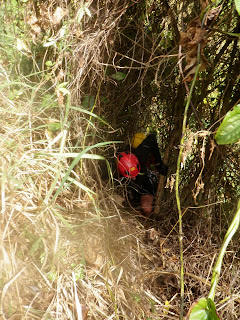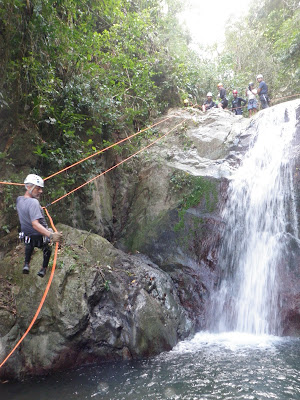
After a week of instruction in canyoneering techniques and rescues in Puerto Rico's southern city of Ponce with American Canyoneering Association founder Rich Carlson, a group of 6 students and Rich went out to attempt the second descent of a canyon called El Barriel. The party included Alfonso and Jorge of Del Sur Adventures who had made the first descent of this canyon, as well as Miguel, Omar, and Ronnie students from the course. Pura Vida Adventures' canyoneering guide, Joe Moerschbaecher who had been down in Puerto Rico taking the course and Rich Carlson completed the 7 person party.
Expectations for the day were a 3 hour canyon descent that would include one 30ft, one 60ft and two 200ft rappels. We took two 200ft ropes and a 30 and 50 ft rope to set up a safety line before the first 200 ft rappel. The plan for the day was one of getting out to just do some canyoneering, minimmum instruction just getting out and playing after a long week of learning and drilling canyoneering techniques. What would come next was a real life exam in the skills we had learned and drilled for the past week.

Things went smoothly during the first rappel of 30 feet. We continued on to the 60ft rappel. The rigging used for this rappel was the Joker technique. The first three people made it down without incident. As Rich rigged to descend he noticed a core shot. He isolated the core shot. Once he got what he thought was confirmation the rope was long enough he began his descent. As he descended down he stopped and a give rope signal was given to us from the bottom. We gave Rich more rope on the Joker rigging system and all seemed to be well.
I rappelled next after confirming with Jorge the plan for breaking down the system with the new knot in the rope which isolated the core shot. Jorge assured me he had it all worked out and I was confident he did. When I descended down I saw the landing spot for the rappel. It was a ledge which was diamond shaped 2-3 ft long on the ends and 5-6ft long in the middle. The rappel rope had been knotted on the end, which eased my mind a bit, and as I sat in the falls still on the rappel I was a little puckered as I saw it would take a rappelling traverse to reach the ledge which was the only stationing area for the 200ft rappel to come next.
 The ledge between the 60ft and first 200ft rappel
The ledge between the 60ft and first 200ft rappelAfter digesting where I was and where I needed to go and pleased by the fact that the end of the rope was knotted. I committed to the bottom portion of the rappel and made it to the ledge. Ronnie offered assistance as I took myself off rappel. I now sat on the ledge but it was quite intimidating. I felt a life line would have truly been appropriate, but this was only the second descent and with no additional bolt placements available due to the conservation of the drill battery on the first descent there was no good way to place the lifeline.
As I got to the ledge Alfonso was rigging the next rappel which was 200ft. He was down first followed by Miguel. We were slowed a bit by the core shot but the problem had been solved and once again we had a good flow with everyone now on the ledge with the exception of Alfonso and Miguel who had already completed the next rappel. Ronnie rigged and began the 200ft rappel next, Rich observed as Ronnie began his rappel. Ronnie's eyes lit up Rich saw the core shot which had caused Ronnie's eyes to grow. Rich said to Ronnie why don't you ascend back up here. Ronnie calmly did. Rich's next words were "We are f_ _ _ ed" when canyoneering guru, Rich Carlson says this you tend to believe him.
After a short period of initial shock everyone began to evaluate options. Jorge left the 60 ft rappel up above in case we needed to use it to ascend back up because above the 60ft rappel it would be easy to exit the canyon left side. This was an option but would be a difficult ascent up a small waterfall which would cause the rope to rub the edge as water hit the body of the ascending person. Another option seemed available along the canyon left side of the ledge we were on, about 15 feet up it seemed it would be easy to scramble out of the canyon.
This I thought was the solution and as I mentioned it to Rich he was already in the process of bringing out his rescue bag and tying a large knot to see if we could catch anything when we went fishing, throwing the knot and rope above us to see if we could snag on something, anything. We began to work on this option as Jorge began to attempt to ascend the rope. If he could get above the 60 ft rappel he could then come around and set a rope on canyon left for the rest of us to ascend out both parties got to work and soon Jorge came back saying that the ascent may be possible but was risky and we should try fishing for a while. Jorge then turned his attention to Miguel and Alfonso managing the rope as they made their individual ascents up.
After about a dozen tries we seemed to have gotten a snag with the fishing line. Not sure how good a snag we had Rich and Ronnie assisted me up using a pyramid to minimize the weight we put on the snagged rope. As I left the pyramid and transferred a little more weight to the handline two thoughts went through my mind: the first thought was if I can get up another 5 ft. our problems should be solved, the second thought was if this handline gives I am going to take a bit of a tumble down. I had tested the line from the ground before beginning and was pretty confident it would hold. As I made it up the 15ft and let go of the lifeline on top I saw it had snagged between the rock face and a small dead shrub.
I grabbed the end of the rope and began moving up the side of the canyon another 8 feet where I found a suitable tree to use as an anchor. We were back in business Miguel had began his 200ft. ascent back up, Jorge was managing their ascending rope and soon after Omar and Ronnie had ascended up the side of the canyon which would be our escape route out. While others began the shorter ascent out of the canyon and Alfonso began the 200ft ascent I scouted ahead to find an exit route. Everyone made there way out of the canyon onto the bank and I pointed people to what I saw ahead and what I believed was the best way out.
Rich and Ronnie continued to explore up ahead and the other 5 of us grouped together and followed the trail they had made as they pushed their way through the vines and grass.
 The bushwack out
The bushwack outSoon after that we were back at the car and after a short drive at a bar telling the story from each individual perspective. At the bar Alfonso and Jorge told the story of their first descent and Rich asked the name of the canyon El Barriel was what they replied saying it was the name of the major tributary of which the canyon flowed in. I commented to Jorge and Alfonso that I would have called it Garganta del Dieblo (throat of the Devil). Jorge laughed and said he liked that name, so whether it is called El Barriel or Garganta del Dieblo is up Jorge and Alfonso, but I believe this particular trip would best be described as travelling through Garganta del Dieblo.
 View of the canyon from above
View of the canyon from aboveSometimes canyoneering courses seem to cover all the worst case scenarios and you say to yourself when will I need to use these skills. Sure it is true if everything always goes right you will not need to use many of these worse case scenarios skills, but when things go wrong you may need use many of these tools. Some of the tools we needed to use on this trip, which would not have been used if all went well included: isolating a core shot, lowering on a releasable system, passing a knot on ascend and rappel, locking off your rappel device, "fishing" pot hole escape, pyramid pot hole escape, land navigation, and bushwacking.
Video of the first descent of Garganta del Diablo
Video of the first descent of Garganta del Diablo
Pura Vida Adventures offers canyoneering instruction and guided canyoneering trips. Find out more at http://www.rappellingwaterfalls.com/




